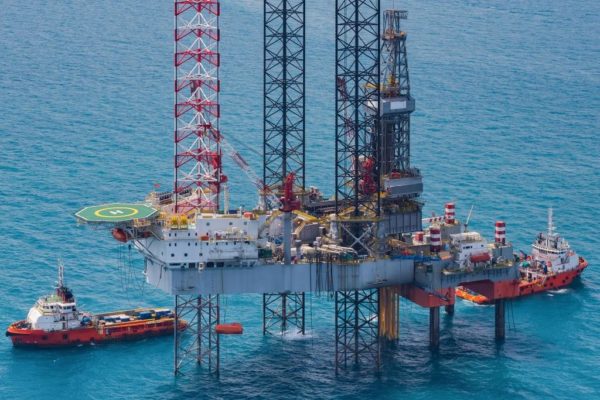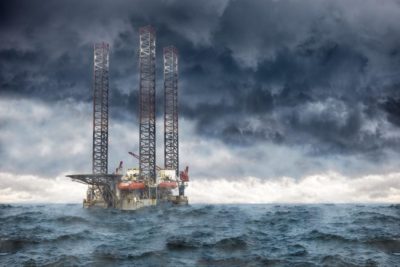Technological advances and the exhaustion of shallow-water prospects have led oil companies to explore at greater depths, erecting large platforms within the immensity of the sea. In this context, Latin American is the region posied to receive a large part of the money invested in these ultra-deepwater installations.
While the first oil well drilled off the coast was the Bibiheybat field, in Baku, Azerbaijan, in 1846, the Maunsell Forts, small fortified towers built in the Thames and Mersey estuaries during the Second World War, are considered the precursors to modern platforms.They were built on land out of concrete, outfitted with Bofors anti-aircraft guns and radar 46, and deployed with the help of barges.
Since then, much has evolved leading up to the present. This is exemplified by the construction of oil behemoths in the middle of the ocean, such as the Berkut Oil Rig, in the Ojotsk Sea (Russia), which weighs 200,000 tons, and the Hibernia, erected in the middle of the Atlantic Ocean off the coast of Newfoundland (Canada), whose 37,000-ton production facilities sit on top of an additional 600,000-ton base.
Depending on the setting, these oil rigs can be fixed to the bottom of the ocean or floating. Customarily, they are built relatively close to the coast. However, technological improvements have allowed for placing them ever-farther offshore to be able to explore deep waters in Brazil (16,400 feet) or the vast potential reserves in countries such as China, Argentina and the United Kingdom.
Main producers
Five countries are currently responsible for 43% of total offshore oil production: Saudi Arabia, Brazil, Mexico, Norway and the United States.

The Saudis are the largest offshore oil producers in the world, with deposits such as the Safaniya Oil Field. Considered the largest offshore oil field by Forbes Magazine, it produces between 1.1 and 1.5 million barrels of oil per day. With it and other deposits, Saudi Arabia is responsible for 13% of global production. Brazil is currently in second place. Between 2005 and 2015, offshore production in this country grew 58%. The expansion of projects in ultra-deepwater pre-salt and fields such as the Lula oil field (the fifth largest in the world according to Forbes) have been the primary drivers of this growth (Pre-salt is a geological formation on the continental shelf that sits below the salt layer on the seabed.The total depth of the discoveries from the surface to the oil reserves beneath the salt layer can be more than 21,000 feet).
Also in Latin America, Mexico is the third largest offshore producer. This country produced close to two million barrels per day in 2015, 7% of global offshore production.
“Today, five countries are responsible for 43% of total offshore oil production: Saudi Arabia, Brazil, Mexico, Norway and the United States.”
It is estimated that the Trion oil field, located in the Maritime Frontier Zone with the United States and with a depth of 8,200 feet, has total 3P reserves, which are equal to 485 million barrels of crude oil.
Just off the offshore producer winners podium, occupying fourth place, is Norway, thanks to its North Sea reserves. Yet, as consulting firm Douglas Westood notes, this European Nordic region will enter into a decline between 2016 and 2040, due to the maturity reached by the majority of its oil fields and the dismantling of the most obsolete platforms.
Despite a 28% decrease in offshore production between 2005 and 2010 in this country, supply has remained stable since 2010, representing 7% of global offshore production.
Meanwhile, on the other side of the Atlantic, the United States maintains a solid position in offshore production world rankings (as in onshore production), thanks to oil fields in the Gulf of Mexico. From 2005 to 2015,offshore production in this region grew by 6.5%, and new discoveries are being made all the time.

The Gulf of Mexico and reserves discovered in Latin America are examples of the opportunities and challenges that deep-water extraction presents, as it entails greater complexity, higher costs and increased operational risk.
Deep-water exploration
Technological advances developed by specialized drilling companies like Schlumberger, Halliburton and Baker Hughes and the exhaustion of shallow-water prospects have led companies to explore ever deeper. Most deep- or ultra-deepwater production take place in four countries: Brazil, the United States, Angola and Norway.The first two represent together more than 90% of global ultra-deepwater production.
An eye is also being kept on new players like China, Argentina and the United Kingdom. As floating production systems (FPS), which historically have been a good indicator, show, in the coming years, Latin America is poised to stand out in this field.
“According to consulting firm Douglas Westwood, “geographically, the region with the most momentum in this sector will be Latin America.”
According to consulting firm Douglas Westwood, geographically, the region with the most momentum in this sector will be Latin America. Its report states that this region of the globe will receive most of the money invested in searching for oil in ultra-deepwater in countries such as Brazil, which, in turn, requires greater investment. Asia and Africa are the other regions where the FPSO sector is going to pick up pace. Again, investment here will depend on the setting in which the operators work. In Africa, like in Latin America, work is going to be performed at increasingly greater depths. Meanwhile, in Asia, operations are going to be simpler and require less investment because the oil fields are located in relatively shallow water.
Against that background, experts emphasize the need to continue developing safety and prevention systems to ensure the projects are efficient, given that the future as well as the competitiveness of this sector depends on caring for these resources.
*Floating production system:A semi-submersible platform outfitted with drilling and production equipment.Cables or chains anchor it in place, or it can placed with dynamic positioners using anchors that rotate. Production from submerged wells is transported to the surface through vertical ducts (risers) designed to absorb the movement of the platform. The FPS can be used at depths ranging from 590 to 9,840 feet.
This how we raise a platform the size of Big Ben
In 1987, the Yme field was discovered in the Egersund Basin, in Norway. After working on this platform for 30 years, Repsol has decided to relocate the installation through an innovative system that has become a milestone in oil field engineering.
Do you how much this mass of iron as tall as Big Ben weighs or how many days it took to accomplish this feat?
Don’t miss this video of REPSOL, published on May 24, 2017, to learn all about this project.





